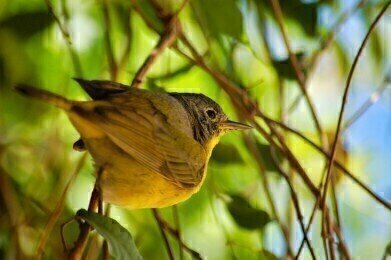News & Views
Introducing the Sichuan Bush Warbler – A New Species of Bird
May 21 2015
A new bird species has been discovered in central China by an international team of scientists.
This shy brown bird, named the Sichuan bush warbler, Locustella Chengi, breeds in the mountainous region of the Sichuan Basin at 1000-2300m elevation. Its winter home is currently unknown.
The Sichuan bush warbler was first noticed whilst singing its distinctive song in 1992 by two members of the research team – Professors Per Alström and Urban Olsson.
First they heard it, then they saw it
Eventually, the two friends caught several fleeting glimpses of a small round-bodied chocolate-brown bird with a dark stubby tail, long pink legs, large dark eyes and a pointy black beak, scampering quickly through the dense underbrush. After listening and watching for a while, they decided this shy little bird was their singer, and that it looked rather like a russet bush warbler, a species that both men had previously seen and heard in northwest Thailand.
Twenty years on
Nearly two decades later, they found the bird again and extensive analysis eventually confirmed their initial hunch that this is indeed a species new to science. Professor Alström had returned to China as a visiting professor at the Chinese Academy of Sciences and was determined to find and identify the mystery bird.
A team was assembled and mounted an expedition to the Qinling Mountains where they collected the first “Sichuan bush warbler” on 28 May 2011. This individual is the holotype for his species and is now housed in the Institute of Zoology at Chinese Academy of Sciences, along with sound recordings and a sample of his DNA.
Later, more individuals were spotted, captured and measured, their songs recorded and DNA samples collected. The research team’s field studies found that the Sichuan bush warbler is locally common, and does not appear to be under any imminent threat. It is very similar to its closest relative, the Russet bush warbler, but the two species are not identical.
Exciting discovery
All new discoveries are exciting and provoke questions, and this one will likely trigger a plethora of interesting research, particularly about evolution and the process of speciation in birds as well as the complex relationships between evolution, ecology, geology and climate.
You don’t need to be a scientist or a birdwatcher to appreciate and get excited by the discovery of new species. As Professor Alström pointed out in email: “All living organisms are interesting, and there are so many cool creatures all over the world that are thoroughly enjoyable to observe.”
If you're interested in seeing more cool discoveries - as Professor Alström puts it - you'd be amazed to hear that researchers have announced the discovery of a new dinosaur fossil: a glider with wings which is similar to both birds and bats. It has been named Yi qi (or Strange Wing). You can read all about the update in: Bat-Dinosaur Fossil Discovered in China.
Digital Edition
Lab Asia 31.2 April 2024
April 2024
In This Edition Chromatography Articles - Approaches to troubleshooting an SPE method for the analysis of oligonucleotides (pt i) - High-precision liquid flow processes demand full fluidic c...
View all digital editions
Events
Apr 24 2024 Jakarta, Indonesia
Apr 25 2024 Istanbul, Turkey
Apr 28 2024 Montreal, Quebec, Canada
May 05 2024 Seville, Spain
InformEx Zone at CPhl North America
May 07 2024 Pennsylvania, PA, USA


















